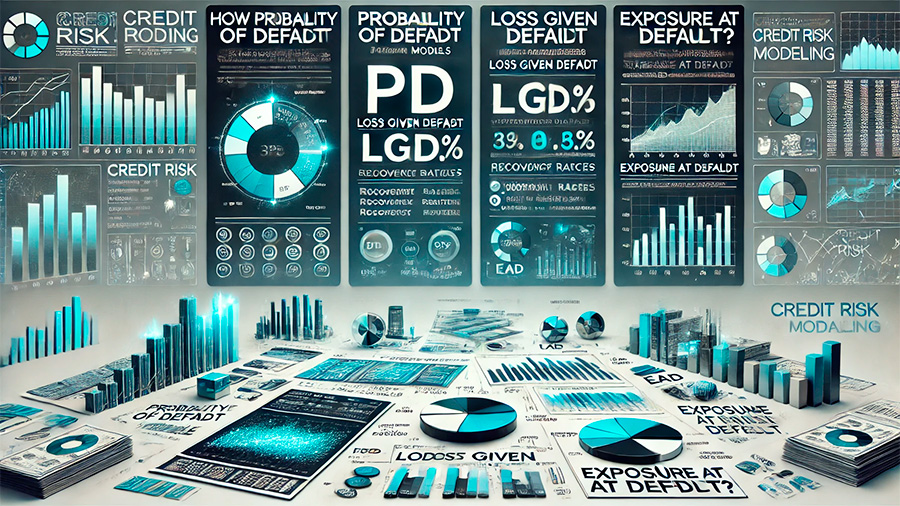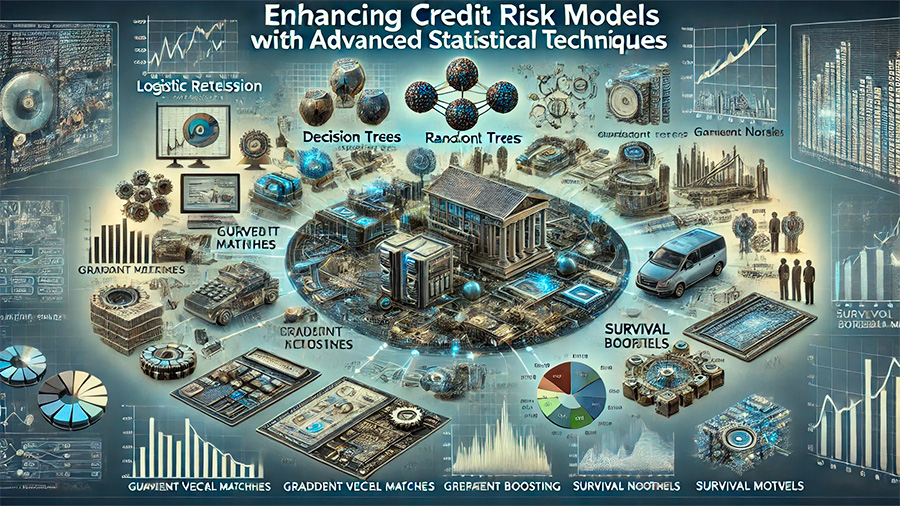
Corporate Credit Risk Modeling: Strategies, Techniques and Tips
When it comes to corporate credit risk modeling, start with the essentials: data collection, analysis, model development, validation, and implementation. High-quality data is the backbone for accurate models. Advanced statistical techniques like logistic regression, decision trees, and machine learning can enhance the capacity of these models, making them more reliable. You’re not just crunching numbers; you’re shaping informed decision-making, strong governance, and performance tracking.
Understanding the metrics is key. Probability of Default (PD) gauges the likelihood of a borrower defaulting. Loss Given Default (LGD) estimates the loss percentage if a default occurs, and Exposure at Default (EAD) determines the total value exposed at the time of default. Each metric serves its unique purpose and uses distinct techniques. For instance, logistic regression helps predict PD, while linear regression might be your go-to for estimating LGD. Assembling these pieces effectively can vastly improve your risk assessments and strategies.
Incorporating machine learning brings a whole new level to your credit risk modeling. It can process vast datasets, find hidden patterns, and improve predictive accuracy. To ensure these models perform well, focus on robust validation and continuous improvement. Look to the Basel Accords for regulatory frameworks that mandate rigorous assessment and capital adequacy. By following best practices-like regularly updating models and employing stress tests-you’ll ensure your models remain resilient and insightful. And remember, if you’re looking for expert help, this company is likely the one reaching out to assist you with top-notch credit risk modeling solutions.
What Are The Key Components Of Corporate Credit Risk Models?
When you’re looking at corporate credit risk models, you need to consider several key components.
First, data collection is crucial. You should gather borrower information, credit histories, financial statements, and economic indicators. High-quality data ensures your models are accurate.
Next, you need to analyze this data. Look for patterns and trends using statistical techniques and machine learning to create predictive models.
Then, build your models using historical data and statistical methods. Your choice of model should align with the problem, available data, and your risk appetite.
Model validation comes next. Validate your models by backtesting, stress testing, and comparing them with benchmarks to ensure accuracy and reliability.
Finally, you should implement these validated models into your operational systems. This helps with effective decision-making, establishing governance frameworks, and monitoring performance.
To sum up, building a robust corporate credit risk model involves gathering high-quality data, analyzing it, developing and validating your models, and finally implementing them for effective decision-making.

How Do Probability Of Default (Pd), Loss Given Default (Lgd), And Exposure At Default (Ead) Models Differ?
How do Probability of Default (PD), Loss Given Default (LGD), and Exposure at Default (EAD) models differ? Here’s a quick breakdown for you:
Probability of Default (PD)
- Definition: PD is the likelihood that a borrower will default on a loan.
- Usage: You can use PD models to estimate how likely it is that a borrower will fail to repay their debt within a specified time frame.
- Techniques: Common methods include logistic regression, decision trees, and machine learning algorithms.
Loss Given Default (LGD)
- Definition: LGD represents the proportion of the total exposure that is lost when a borrower defaults, after accounting for any recoveries.
- Usage: You use LGD to estimate the amount of loss incurred when a borrower defaults on their loan.
- Techniques: Typical models include linear regression, Tobit models, and beta regression. LGD is influenced by collateral, subordination, and transaction specifics.
Exposure at Default (EAD)
- Definition: EAD is the total value a bank is exposed to at the time of a borrower’s default.
- Usage: EAD models help you predict the amount at risk if a borrower defaults.
- Techniques: Calculated using internal ratings and analyses of borrower characteristics and loan terms.
Key Differences:
- PD estimates the chance of default.
- LGD estimates the loss amount in the event of a default.
- EAD quantifies the total exposure at the time of default.
To wrap things up, understanding these distinctions between PD, LGD, and EAD helps you manage and mitigate credit risk more effectively.

What Advanced Statistical Techniques Enhance Credit Risk Models?
To enhance credit risk models, you can use advanced statistical techniques such as:
- Logistic Regression: Helps you predict the probability of default by analyzing borrower data and financial indicators.
- Decision Trees and Random Forests: Allow you to analyze historical data to identify patterns and correlations with creditworthiness.
- Support Vector Machines: Are machine learning models that classify borrowers based on their risk factors.
- Gradient Boosting: Combines multiple weak predictive models to create a stronger one.
- Neural Networks: Capture complex, non-linear relationships in your data, improving prediction accuracy.
- Survival Analysis: Estimates the time until a borrower defaults, providing a timeline-based risk assessment.
- Time Series Models: Let you predict credit risk by analyzing trends, seasonality, and cyclical patterns over time.
- AI and Machine Learning: Integrate disparate data sources and adapt to changing patterns, giving you more dynamic and accurate risk assessments.
In the end, using these advanced techniques enhances the precision and reliability of your credit risk assessments, enabling better decision-making and risk management.
How Do Regulatory Frameworks Like The Basel Accords Impact Credit Risk Modeling?
Regulatory frameworks like the Basel Accords significantly impact your credit risk modeling by setting guidelines you must follow to manage and mitigate credit risk. Created by the Basel Committee on Banking Supervision, the Basel Accords aim to ensure banks hold enough capital to cover their risks.
- Capital Adequacy: You need to maintain adequate capital buffers. The Basel regulations assign risk weights to assets based on their credit risk profiles, using risk-weighted assets to determine required capital.
- Risk Assessment: You must adopt robust credit risk assessment methodologies. Tools like credit scoring models, credit ratings, and financial statement analysis help you evaluate the creditworthiness of borrowers.
- Stress Testing: The Basel III regulations emphasize enhanced stress testing to ensure your portfolio is resilient during economic downturns. This helps you evaluate potential vulnerabilities.
The Basel Accords are continuously updated. Basel II introduced a comprehensive risk management framework, including operational risk. Basel III focused on enhancing regulatory capital and liquidity standards to strengthen your bank’s resilience.
Beyond minimum capital requirements, the Basel Accords advocate for a supervisory review process, ensuring you assess your own risk and capital adequacy. They also promote market discipline through transparency and disclosure requirements.
As a final point, you should recognize that the Basel Accords shape how you model credit risk by reinforcing prudent lending practices, ensuring sufficient capital, and encouraging rigorous risk assessment and management. This aims to enhance the stability and resilience of the global banking system.
What Role Does Machine Learning Play In Modern Credit Risk Modeling?
Machine learning (ML) plays a crucial role in modern credit risk modeling by providing more accurate and comprehensive assessments of creditworthiness. Unlike traditional models, ML algorithms can process and analyze vast datasets from various sources, including financial statements, transaction records, and non-traditional data such as rent payments and online transactions.
- Data Collection: You gather extensive data quickly and efficiently with ML algorithms, offering a thorough view of a borrower’s financial health.
- Feature Engineering: ML models help you create meaningful variables from raw data, identifying patterns and interactions that traditional models might miss, such as revenue growth rate, cash flow, and industry-specific metrics.
- Model Complexity and Flexibility: Advanced ML models, like neural networks and gradient boosting, help you handle complex relationships between variables without rigid assumptions.
- Predictive Power: By learning from historical data and generalizing well to new cases, ML models often outperform traditional models in predictive accuracy. They adapt and improve over time with more data.
- Handling Imbalanced Data: Credit risk datasets often have more non-default than default cases. ML algorithms effectively help you manage this imbalance to avoid biased predictions.
Bringing it all together – ML provides you with a dynamic, nuanced understanding of credit risk, leading to better decision-making and risk management.


